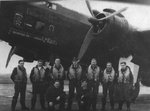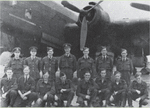Wild Bill Kelso
Recruit
- 3
- Feb 3, 2010
Wondering if anyone out there can help solve a little mystery about the Halifaxes that served with 158 Squadron. It's generally accepted that the undercarriage of Halifiaxes was painted black, just like the underside of the aircraft, but numerous photos indicate that this just wasn't true. This is particularly the case with 158 Squadron. Photos of LV 907 Friday the 13th clearly show the undercarriage was painted a much lighter color. Other 158 planes also display this characteristic, and some get a bit more creative by painting stripes on the landing gear. The question is, what is this color?
Wild Bill Kelso
Wild Bill Kelso
Attachments
Last edited by a moderator:



